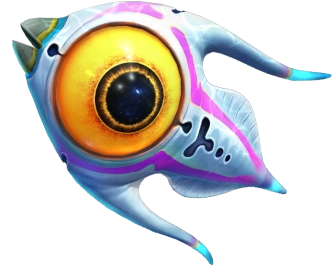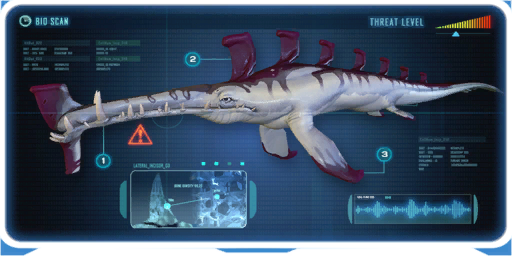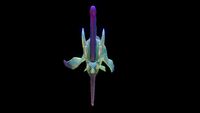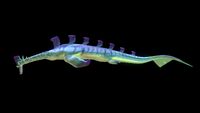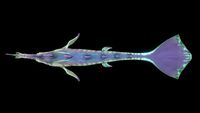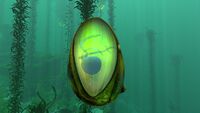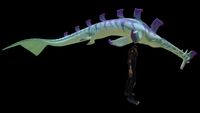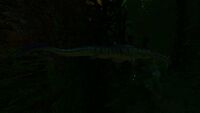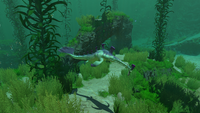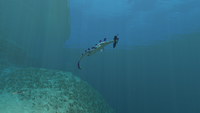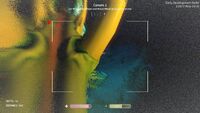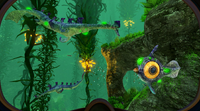Template:Class 2 FaunaThe Stalker is an aggressive fauna species most commonly found populating the Kelp Forest, and occasionally the Crash Zone.
Occasionally, Stalkers can be found swimming into the Safe Shallows while chasing Peepers or other small fauna.
Appearance
The Stalker is a rather large creature, possessing an elongated, smooth body with smooth skin. Its head features a long snout greatly resembling that of real life gharials.
Seven dorsal plates protrude from its back running along from the neck to the tail. It has two pectoral and pelvic purple-tipped fins on each side of the body. The body terminates with a broad, whale-like tail fin.
The Stalker's dorsal side is blue-gray in color and patterned in dark blue and purple, with a bright green and aqua underside.
Behavior
The Stalker seems to have a fondness for a metal; it will approach metal objects such as Metal Salvage, Silver Ore, and Titanium, pick the object up with its mouth, and carry it back to its nest. Sometimes when it picks an object up it will drop one of its teeth. It may also drop them when grabbing a Camera Drone or attacking a Seamoth. These teeth are required for creating Enameled Glass which is needed to make a Cyclops and other large objects. Stalkers will sometimes place metal salvage in a certain area with other pieces.
Stalkers can grab Camera Drones (as mentioned above), including ones housed in their sockets on the Scanner Room and will carry them in their mouth similarly to Metal Salvage. During this time the drones are incapacitated.
Being predators, Stalkers will attempt to chase and eat nearby Peepers and other small prey. They will also attack the player upon close encounters with each bite dealing 30 damage. The player should be cautious while exploring Kelp Forests to avoid getting attacked by surprise, as Stalkers often form small groups that will lurk in the dense Creepvines.
At night, besides being more difficult to spot due to being one of only three non-bioluminescent creatures in the game, Stalkers become more aggressive and have a wider aggressive radius, so it is advised to avoid swimming near Kelp Forests at night without adequate protection.
Stalkers can be found guarding or lurking near their eggs, and will attack if the player gets too close.
Stalkers will also collect ores should the player drop any near them.
|
Spoiler alert: The following section contains story related material. |
|---|
|
The Stalkers inside Primary Containment Facility's Aquarium are not hostile to the player, and are thus not a threat. |
Interactions with the Player
It is possible to temporarily placate a Stalker by feeding them any kind of catchable fish or by giving them metal salvage. Doing any of the above will pacify the creature for a short while. A Stalker will eat any catchable fish, but they prefer Peepers, seeing that they will hesitate before eating other fish.
After being fed, the Stalker will not only become peaceful towards the player, but it will also start looking for metal salvage, pick it up, and drop it at the player's position as a gift. This behavior can be extended by offering more fish or salvage. Stalkers hatched from an Alien Containment will remain passive, but will still steal cameras and attack the player’s vehicles.
Energy Value
Data Bank Entry
|
A streamlined predator encountered in the kelp forests in wait of prey leaving the safety of the shallows to feed. The stalker likely carved out its evolutionary niche at the sweet spot between speed and size millions of years ago, and may be one of the oldest species on the planet. The stalker appears to be attracted to titanium deposits, which tends to sharpen and put stress on its teeth. As with many predators, it may be possible to temporarily distract hungry stalkers by feeding them.
|
Gallery
Trivia
- As of 14.12.2014 the model of the Stalker was changed. Until then, the model of the Lava Lizard was used.[1]
- The Stalker was also listed as Snout Shark in development documents.[2]
- Stalkers, Lava Lizards and Reaper Leviathans are the only creatures that do not have some degree of bioluminescence.
- Although the Stalker cannot damage the Cyclops, it will attack it which normally results in the Stalker losing a tooth.
- Stalkers from the Kelp Forest can be observed wandering into the Safe Shallows quite often. Sometimes they will bump Lifepod 5 causing it to list slightly. Other times a few pieces of metal salvage in an area such as the Safe Shallows will result in a small group of them congregating to play with it which will create a small area dense with Stalkers and danger for an unprepared and sluggish player.
References
- ↑ http://forums.unknownworlds.com/discussion/136215/what-is-the-name-of-the-new-creature-in-the-kelp-field Dated December 2014.
- ↑ https://trello.com/c/egknl2CS/3236-snout-shark-export Dated December 22, 2014.
| Fauna living within the Crater | |
|---|---|
| Carnivores | |
| Herbivores | |
| Scavengers & Parasites | |
| Leviathans | |
| Extinct | |
| Other Entities | |
